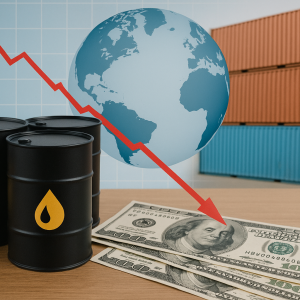Start of 2024 with new tensions, after an end of 2023 with good signs especially in services
Saturday 20 January 2024
Share on
Early 2024 with new tensions and risks, after a late 2023 with good signs, especially in services. Low inflation in Italy, not yet in Europe, and rates expected to fall, but for now credit is more expensive. Investments less negative, but consumption uncertain, while employment is growing. Services on the rise, but in industry a sharp drop and uncertain prospects for Italian goods exports. In the Eurozone, diverging rhythms, in the USA some signs of braking, while China is doing well.
The Italian and International Economy in Brief
- New risks. The year 2024 opened with further risks for trade flows, due to the sharp reduction of transits in the Suez Canal due to attacks by the Yemeni Houti group. Gas and oil prices have not been affected so far, but remain high: in January 31 €/mwh and 78 $/barrel. By the end of 2023, Italian GDP may have fared better than expected: services and construction have rebounded, but industry remains weak; inflation is at its lowest, only in Italy. Rates could therefore remain high for a few more months.
- Low inflation in Italy, not yet in Europe. Italian inflation fell again in December (+0.6% per year, from +0.7%). It jumped, on the other hand, in Germany (+3.8% from +2.3%) and France (+4.1% from +3.9%), so that in the Eurozone average it rose to +2.9% (from +2.4%). The discrepancy is mainly explained by the different trajectories of energy prices, which now fall much more in Italy (-24.7%) than in Europe (-6.7%), due to an adverse 'base effect' in Germany (where the government had curbed them heavily in December 2022). Core prices of goods and services also counted, which continued their slowdown everywhere, but in Italy they had already returned to just below +3.0%, while in the Area they maintained a greater pace (+3.4%).
- Rates expected to fall. Sovereign rates were not affected by the reforms regarding Europe (agreement on the Stability Pact, non-ratification of the ESM): the Italian BTP in January was stable at 3.63%, the Bund at 2.14%; the spread remained at 149 points. This reflects the downward expectations on central bank rates: the markets expect the FED rate still firm at the end of January (5.50%) and the first cut in March; also in the Eurozone they expect ECB rates firm this month (4.50%) and a cut in March-April. The recent rise in inflation has therefore not dented market optimism, but may dampen ECB moves.
- More expensive credit. In November, there was yet another increase in the cost of credit for Italian businesses (5.59% on average). Conversely, for the second month, the fall in loans eased (-4.8% per year, from a low of -6.7% in September), although credit remains a factor holding back investment and consumption.
- Less negative investments. Qualitative data point to a less unfavourable dynamic in Q4, after the decline in Q3: conditions for investment improve, but remain negative (-20.9% from -31.0%) and the outlook for capital goods expenditure (16.0%, from 11.1%); demand plays little favour. In December, however, business confidence in the sector dropped.
- Uncertain consumption. After a robust Q3, mixed signals on consumption in Q4. Retail sales recovered in October-November (+0.6%), but food sales were weak; in December, household confidence rebounded, ICC marks an annual +0.5%, but car sales slowed (-3.7%).
- Work is growing. The positive trend in the labour market was confirmed: +450 thousand employed in November since the end of 2022. The growth in October-November (+122 thousand) was entirely attributable to permanent workers (+0.9%, +143 thousand); fixed-term (-0.3%) and self-employed workers (-0.3%) fell.
- Rising services. In October and November RTT (CSC-TeamSystem) indicated a recovery of activity in services, and in December, according to the HCOB PMI, the decline was almost reversed (49.8, from 49.5), a figure consistent with the strong rebound in business confidence at the end of the year, especially in tourism.
- Industry: sharp decline. In November, production fell again sharply (-1.5%; -3.1% trend); the increase in turnover reported by RTT is explained by a large decumulation of inventories. In Q4, the acquired change in production is -1.1%. The slightly upward HCOB PMI (45.3 from 44.4) anticipates an improving December, but business confidence continued its downward trend. And in early 2024 the Suez 'blockade' (if prolonged) may worsen the scenario.
- Eurozone: diverging rhythms. The drop in industrial production in November (-0.3%), the third in a row, hides differentiated dynamics: Italy and Germany (-0.3%) suffered, while Spain (+1.1%) and France (+0.5%) performed positively. The weakness of manufacturing indicates a very weak Eurozone dynamic in Q4, as services are also contracting (PMI in December at 48.8).
- USA on the brakes? In November (+0.2%) and December (+0.1%) industrial production recovered little after October's decline (-0.8%), leading to a negative Q4 (-0.8%). And in December, the Chicago Purchasing Managers' Index and the manufacturing PMI fell (47.9 from 49.4), only the ISM improved. But jobs returned to high growth (494 thousand in Q4), supporting consumption.
- Good China. The economy accelerated in Q4, above expectations, mainly due to improved consumption. In November, industrial production posted the highest growth in 2023 (+6.6% annually), driven by cars (+20.7%); indicators point to a further jump in December. Expectations for 2024 remain cautious, consistent with hiring by companies declining for four months.
Focus of the month - Uncertain prospects for Italian goods exports
- Less export... Exports of Italian products shrank in 2023 (-1.4% in the first eleven months, compared to the same period in 2022, at constant prices), against a backdrop of profound weakness in world demand for goods (-2.2% trade in the first ten months).
- ... but signs of improvement at the end of the year. In Q4, Italian exports are estimated to have recovered (+1.5% in October-November compared to Q3), albeit with a fluctuating monthly dynamic. In manufacturing, foreign sales were higher than in October-November 2022 (+0.6%). This dynamic was better than that recorded by Italian manufacturing (-2.5%), which was also held back by weak domestic demand for goods.
- High sectoral variability... Italian exports and production are expanding in core sectors, which are strongly integrated in global value chains, such as means of transport (also thanks to the restart of the automotive industry), machinery and equipment, and electrical appliances. Oil products, pharmaceuticals (which had experienced an export boom with the health emergency) and electronic products increased production, despite a drop in exports. On the other hand, energy intensive sectors (such as wood and paper, metallurgy and metal products, non-metallic minerals), which are most affected by still expensive energy in 2023, are generally declining. On average, however, the sectors that recorded better results abroad show more favourable dynamics of industrial production (and vice versa), confirming the importance of foreign demand as an activator of Italian manufacturing, and as a litmus test of its competitiveness compared to other countries.
- ... and outlet markets. The dynamics of Italian exports are also very heterogeneous in terms of destination markets, due to economic, technological and geopolitical forces, which act unevenly and even distortingly, pushing towards a reconfiguration of Italian production chains abroad, especially in 'strategic' products. Connections with the USA have increased, both as a destination market (first non-EU) and as a supply market. The Chinese share in Italy, on the other hand, fell sharply, particularly in electronic and ICT products; however, Chinese purchases of motor vehicles boomed (+165% in the first eleven months of 2023), while the respective Italian sales in China halved. Purchases from Russia were decimated (-85%), with oil and gas supplies substantially halted. Pharmaceutical supply chains partly shifted from Belgium (major European hub) to Switzerland, the Netherlands and the USA.
- Prospects for 2024 not reassuring. The escalation of the Yemeni Houthi group's attacks on shipping vessels at the entrance to the Red Sea has resulted in major international shipping companies (MSC, Maersk, CMA CGM, Hapag-Lloyd, followed by oil companies such as British Petroleum and Frontline) suspending transit through the Suez Canal and diverting their routes south of the Cape of Good Hope (about 10 days more sailing). In mid-January, ship traffic in the Red Sea more than halved (-55% compared to Q4 2023; Redsea Kiel institute data) and the cost of transporting containers from Asia to Europe increased by 92% (Shanghai Containerized Freight index).
- Crucial sea routes. 90% of global trade volume is by sea; of this, before the crisis, 12% transited via the Suez Canal. For Italy, 54% of trade is by ship, of which 40% via Suez; above all, more than 90% of Italy's flows with the main countries east of the Red Sea (in Asia and part of the Middle East) transit by sea. Potentially exposed are: trade in oil and gas (from Kuwait, Qatar, UAE, Iraq; part of Saudi Arabia's oil is instead shipped north of Yemen), those of electronic goods and electrical appliances (more than half of non-EU imports come from China), those of leather products (almost a third comes from China), those of machinery (mainly outgoing to the main Asian countries). The economic impact of the collapse of maritime transport through the Suez Canal is strongly conditioned by its persistence: the more prolonged it is, the greater the negative effects on Italian and global foreign trade will be.






















